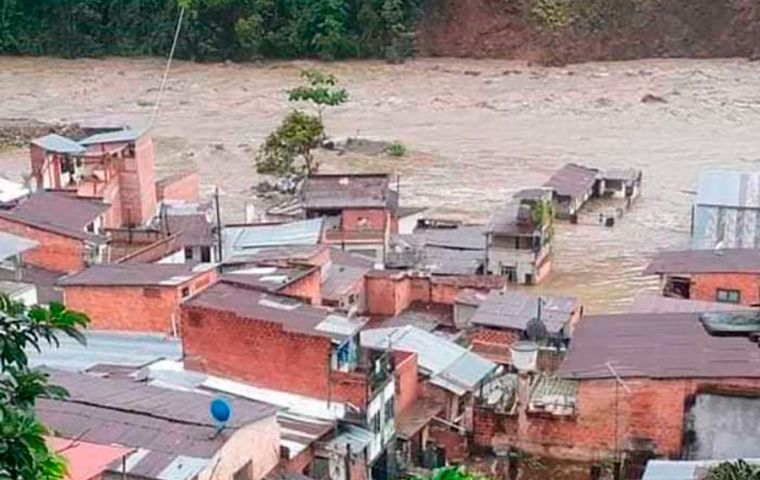MercoPress. South Atlantic News Agency
Bolivia under orange alert as many rivers might overflow
 An orange alert “is declared when the upward trend of river levels and the persistence and intensity of rains indicate the possibility of overflowing rivers in the coming hours,” said Senamhi
An orange alert “is declared when the upward trend of river levels and the persistence and intensity of rains indicate the possibility of overflowing rivers in the coming hours,” said Senamhi Bolivian authorities have enacted an orange alert after eight rivers were determined to be at imminent risk of overflowing, which would affect eight departments nationwide, the National Meteorology and Hydrology Service (Senamhi) reported. The measure will be in force until Jan. 7.
”Progressive and sudden rises in level with possible overflows in the basins of the Bermejo, Guadalquivir, Tupiza, Tumúsla, Pilcomayo, Parapetí, Cuevo, Grande, Mizque, Caine, Chapare, Ichilo, Piraí, Yapacaní, Beni (Headwaters), Maniqui, and Isiboro rivers,“ the Senamhi said in a statement.
The warnings were issued due to the rains that will continue during the following days in the departments of Tarija, Potosí, Chuquisaca, Santa Cruz, Cochabamba, La Paz, Beni, and Pando.
The river overflow warning, issued for the third time in the last four weeks, emphasizes progressive and sudden rises in water levels due to the heavy rains expected. An orange alert ”is declared when the upward trend of river levels and the persistence and intensity of rains indicate the possibility of overflowing rivers in the coming hours,” said Senamhi.
The agency also warned that from January 2 to 5 overflows were expected in the Guadalquivir and Bermejo river basins in the department of Tarija, which would affect the San Juan del Oro, Pilaya, Pilcomayo, Guadalquivir, Erquis, Bermejo, Salinas and San Telmo rivers.
In the department of Potosí, overflows are forecast from January 2 to 4 in the San Juan del Oro, Tumúsla, and Alto Pilcomayo basins, which would affect the San Juan del Oro, Yura, Vitichi, Cotagaita, Tumúsla, Tupiza, Quebrada San Antonio, Quebrada Remedios, Sococha, and Alto Picomayo rivers.
The Grande, Pilcomayo, and Parapetí river basins in the department of Chuquisaca are also expected to see increased flows.
Similarly, possible rises are expected this week in the Middle Mamoré river basin in the department of Santa Cruz, which would affect the Ichilo, Yapacaní, Surutú, Mizque, Piraí, Callejas, Pantano, Grande, San Julián and Cuevo rivers.
Between January 3 and 5, a flood warning has been issued for the upper headwaters of the Mamoré River in the department of Cochabamba, which would affect the Ichilo, Ivirgarzama, Magareño, Chimoré, Mamorecillo, Chapare, Chipiriri, Eterazama, Ichóa, Isiboro, Venticuatro, Mizque, Caine, Arque and Tapacarí rivers.
The alert for the north and Yungas of La Paz is in effect from January 3 to 6, due to water increases in the upper basin of the Beni river which would affect the tributaries of Cotacajes, Boopi, Tamampaya, Solacama, Taquesi, Zongo, Coroico, Yara, Alto Beni, Tipuani, Mapiri, Aten, Cuñada, Tequeje, Toromonas and Enatahua.
In the department of Beni, overflows are expected in the middle basin of the Mamoré river, affecting the Maniqui, Hondo, Tijamuchi, and Isiboro rivers.
In the department of Pando, the alert is in effect from January 2 to 7, due to possible overflows in the Madre de Dios, Tahuamanu, and Manuripi rivers.
Several departments of the South American country have been facing difficulties since the end of 2023 due to heavy rains, such as the town of Las Mercedes, in the municipality of La Asunta, La Paz, where landslides have affected some 60 homes.
The overflowing of the tributary in Cotagaita (Potosí) in early December left at least three people dead and caused considerable damage to houses and crops. Two other people lost their lives when the vehicle in which they were traveling fell into the Mapiri river in the municipality of Guanay, in northern La Paz.




Top Comments
Disclaimer & comment rulesCommenting for this story is now closed.
If you have a Facebook account, become a fan and comment on our Facebook Page!